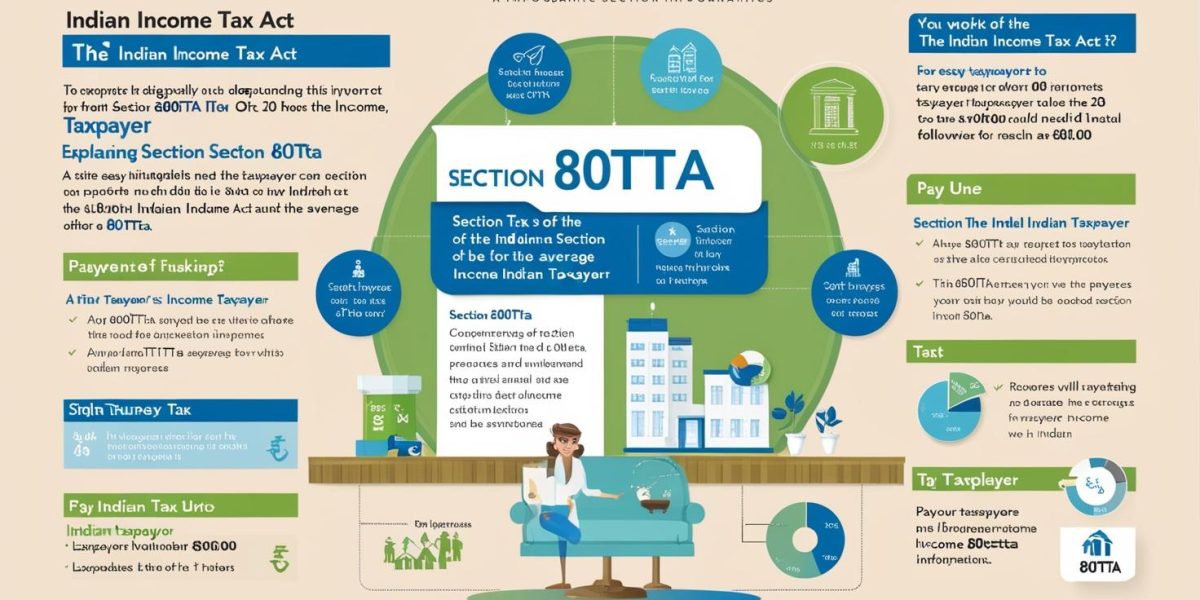Ever feel like you’re paying tax even on the tiniest income—like the few hundred bucks you get as savings account interest? You’re not alone. But here’s the good news: there’s a legal way to save on that, thanks to Section 80TTA of the income tax system.
Let’s break it down in plain English—no jargon, no confusion.
What Is Section 80TTA in the Income Tax Act?
A Basic Explanation
Section 80TTA allows individuals and Hindu Undivided Families (HUFs) to claim a deduction up to ₹10,000 per year on the interest earned from savings accounts.
Objective Behind the Provision
The government introduced this section to reduce the tax burden on low and middle-income earners, encouraging them to save more.
Who Can Claim Section 80TTA?
Eligibility Rules
You can claim this deduction if you:
- Are an individual below 60 years of age
- Belong to a HUF
- Are a resident taxpayer
Difference for Senior Citizens
Senior citizens (aged 60+) should opt for Section 80TTB, which offers a higher deduction limit of ₹50,000.
What Types of Interest Income Qualify?
Savings Bank Accounts
Interest from savings accounts in:
- Nationalized or private banks
- Co-operative banks
- Post offices
is covered under Section 80TTA.
Post Office Savings
Yes, even the humble post office savings account qualifies for this deduction.
What’s Excluded from Section 80TTA?
FD and RD Interest
Interest earned from fixed deposits and recurring deposits is not covered under this section.
NRE/NRO Account Interest
If you’re an NRI, interest from NRE accounts is already tax-free, and NRO interest doesn’t qualify for this deduction.
Maximum Deduction Allowed
The ₹10,000 Limit
You can claim up to ₹10,000 per year in interest deduction under Section 80TTA. If your total interest is lower, you claim the actual amount.
How It Works If You Earn More
Suppose you earn ₹13,000 in interest:
- You claim ₹10,000 under 80TTA.
- The remaining ₹3,000 is taxable under “Income from Other Sources.”
How to Claim Section 80TTA in Your ITR
Filing Tips
- Calculate your total interest earned from all eligible accounts.
- Report it under ‘Income from Other Sources’.
- Claim the deduction under Section 80TTA in Chapter VI-A of your income tax return.
Common Mistakes to Avoid
- Don’t forget to report the full interest earned, not just the deductible amount.
- Don’t confuse 80TTA with 80TTB if you’re a senior citizen.
Section 80TTA vs Section 80TTB
Key Differences
| Feature | Section 80TTA | Section 80TTB |
| Who can claim | Individuals <60, HUFs | Senior citizens (60+) |
| Deduction limit | ₹10,000 | ₹50,000 |
| FD/RD Interest | ❌ Not covered | ✅ Covered |
Who Should Use Which?
- If you’re under 60, stick to 80TTA.
- If you’re 60 or older, go for 80TTB for higher benefits.
Why This Deduction Matters
Helps Small Taxpayers
For someone with modest interest income, Section 80TTA can provide meaningful tax relief.
No Investment Required
Unlike other deductions, you don’t need to invest anything—just maintain a savings account and you’re good to go.
How to Calculate Interest on Savings Accounts
Manual & Bank-Generated Reports
Check your monthly bank statements or request a yearly interest summary to know exactly how much you earned.
Tools You Can Use
Apps like ClearTax, Quicko, or even your bank’s net banking can help auto-calculate your total interest income.
Real-Life Examples
Salaried Employee
Ravi, 32, earns ₹7,500 in interest across two savings accounts. He reports the full amount and claims the deduction under 80TTA—saving tax on every rupee.
College Student
Aarti earns ₹2,000 as interest. Since she has no other income, filing ITR helps her legally declare and deduct this amount, ensuring zero tax liability.
How to Make the Most of Section 80TTA
Optimizing Your Savings
Use multiple savings accounts (if needed) to spread your funds and track interest.
Combining With Other Deductions
Section 80TTA can be claimed alongside 80C, 80D, and other deductions to maximize your total tax benefits.
Misconceptions About Section 80TTA
Interest Is Fully Tax-Free?
Nope. Only up to ₹10,000 is tax-deductible. Anything beyond that is taxable.
Applicable on FD?
Definitely not. FDs and RDs do not qualify under this section.
Conclusion
Tax-saving doesn’t always need to be complicated—and Section 80TTA proves that. With zero investment, minimal paperwork, and a decent deduction, this provision is ideal for salaried employees, students, and small savers across India.
Just make sure you calculate your interest correctly, report it properly, and use this deduction wisely in your next income tax return.












